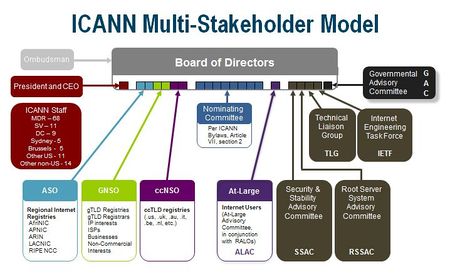Difference between revisions of "Multistakeholder Model"
| Line 66: | Line 66: | ||
# [[Risk]] | # [[Risk]] | ||
# [[Structural Improvements]] | # [[Structural Improvements]] | ||
| − | ==President's Committees and Board Working Groups== | + | ===President's Committees and Board Working Groups=== |
| − | # Board IDN Variants Working Group | + | # [[Board IDN Variants Working Group]] |
| − | # CEO Search Committee | + | # [[CEO Search Committee]] |
==References== | ==References== | ||
Revision as of 07:04, 25 February 2012
A Multistakeholder Model is an organizational framework or structure which adopts the multistakeholder process of governance or policy making which aims to bring together the primary stakeholders such as businesses, civil society, governments, research institutions and non-governments organizations to cooperate and participate in the dialogue, decision making and taking action in providing solution to a problem or in achieving a common goal. A stakeholder refers to an individual, group or organization that has a direct or indirect interest or stake in a particular organization. It is affected or it has the ability to contribute or influence the organizations actions, decisions and policies to achieve results.[1]
Characteristics of Multistakeholder Process
A multistakeholder process has the following characteristics:[2]
- Involvement of stakeholders in the learning process
- Stakeholders work towards a common goal
- Works involve different sectors and scale
- The objective is focused to bring about change
- Deal with structural changes
- Agreements are created based on cooperation
- Stakeholders deal with power and conflict consciously
- Botton-up and top-down strategies are integrated in governance and policy making
The ICANN Multistakeholder Model
The Internet Corporation for Assigned Names and Numbers is an example of a multistakeholder model organization. ICANN is composed of different internet stakeholders around the world and practices a consensus-based policy development also known as "bottom-up" model. ICANN's governs on the principle of cooperation and collaboration with the different internet stakeholders worldwide to be able to effectively and efficiently carry-out its responsibility as the international internet governing body.[3]
As the global internet governing body, ICANN's primary role is to coordinate the internet naming system worldwide.[4] According to ICANN CEO Rod Beckstrom, the ICANN multistakeholder model serves as the catalyst for the internet and he describes it as open, inclusive, balance, effective and international.[5]
ICANN implement the multistakeholder process through the following:[6]
- Regular meeting is conducted by the ICANN Board
- The Supporting Organizations, Councils, Advisory Committees also meet regularly
- Provides a defined Policy Development Process (PDP) for its Supporting Organizations
- A public meeting forum is maitained by the international internet governing body
ICANN Structure
The ICANN Structure is consist of the following:[7]
- Board of Directors
- ICANN CEO & President
- Nominating Committee
- Technical Liaison Group
- Governmental Advisory Committee
- Internet Engineering Task Force
- Addressing Support Organization
- At-large Advisory Committee
- Security and Stability Advisory Committee
- Root Server System Advisory Committee
Board Committees
- Audit
- Board Governance
- Compensation
- Executive
- Finance
- Global Relationships
- IANA
- Public Participation
- Risk
- Structural Improvements

